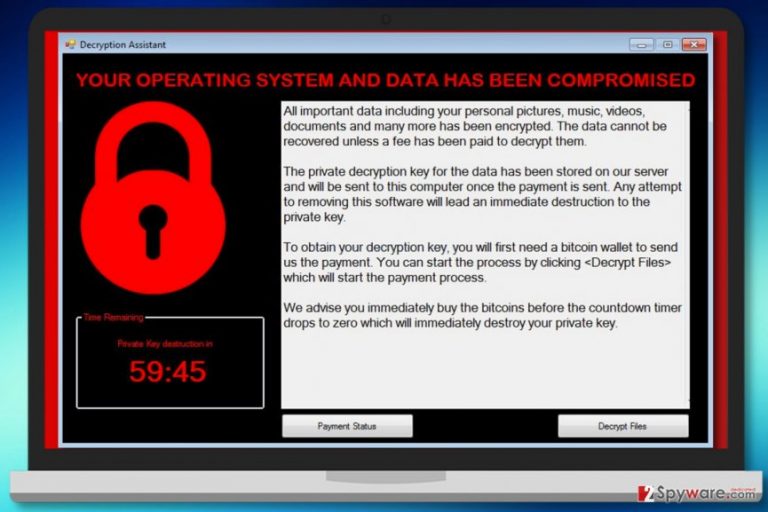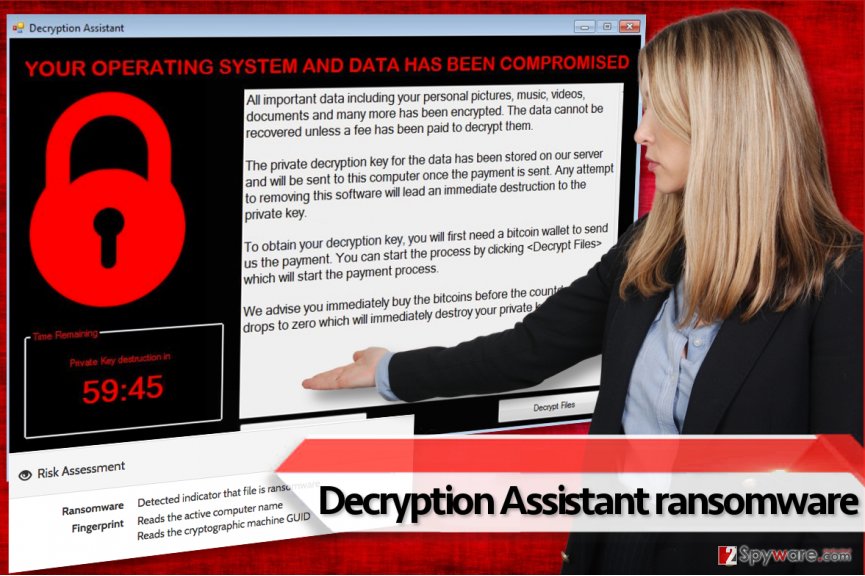Decryption Assistant ransomware / virus (Simple Removal Guide) - Free Guide
Decryption Assistant virus Removal Guide
What is Decryption Assistant ransomware virus?
Definition of in-development Decryption Assistant ransomware
Decryption Assistant virus is a ransomware that spreads in the form of a fake Flash Player Update. If the victim agrees to install it, the ransomware encrypts all data stored on the computer and adds .pwned file extension to every touched file. The sample of ransomware emerged in free online malware scanning sites, and analysts quickly realized that it is an in-development ransomware variant. Identified malicious executives were not able to infect all files on the computer, but only in a C:\chicken folder, which obviously looks like a test one. There are no doubts that the virus is going to be improved shortly. This Hidden-Tear[1] based ransomware uses AES algorithm to lock files securely, and a demands ransom paid in Bitcoins. Bitcoin is a cryptocurrency that almost all ransomware developers command victims to use to pay the ransoms[2], and it is often blamed for accelerating the ransomware industry since it allows transferring and receiving payments anonymously. If you were infected by this ransomware, do not even consider paying the ransom. The criminals might not even be able to help you and restore your files because at the moment it seems that this virus was developed by amateurs. Therefore, we recommend you remove Decryption Assistant ransomware using FortectIntego or SpyHunter 5Combo Cleaner malware removal software.

HiddenTear ransomware that was mentioned above is an open-source virus, and it seems that it has inspired a lot of wannabe cybercriminals to start developing their very own ransomware programs. Of course, such script kiddies hardly can develop a computer program, therefore their creations are weak and can be easily decrypted (in most of the cases). At the moment, there are no known decryption tools that could unlock .pwned files, but we suggest you remain patient and wait. If you have a data backup, you can speed up the data recovery process right now. If you do not, follow instructions provided below the article. Remember that Decryption Assistant removal should be carried out before trying to decrypt your data.
Distribution of Hidden-Tear based ransomware viruses
Almost all ransomware viruses created using pieces of HiddenTear’s source code are distributed via malicious spam. Amateur ransomware developers are too inexperienced to employ techniques such as malvertising, RGP attacks or exploit kits; therefore they rely on the most basic, yet the most efficient ransomware distribution method. They send out thousands of convincing, but deceptive emails that contain malware. Typically, they conceal the malicious file by giving it a safe-looking name, for example, Invoice or Resume. If the victim gets on the hook and lets his curiosity win, the ransomware infects the system immediately. To avoid such situations, we suggest keeping clear from emails that come from unsolicited or unknown individuals.

Decryption Assistant ransomware removal methods
DecryptionAssistant is a critical program, therefore it must be removed professionally. When speaking about ransomware, we never suggest removing it manually, because such viruses do not only drop their files on the system but also perform changes on it, for example, meddle with Registry keys. To reverse the damage made by the ransomware, we suggest you remove Decryption Assistant virus using anti-malware software. Our suggested program FortectIntego can also optimize the system afterward, which we consider being a significant advantage if compared to typical anti-malware programs. However, even the most powerful programs need to be started properly, so we suggest you follow Decryption Assistant removal tutorial that we provided.
Getting rid of Decryption Assistant virus. Follow these steps
Manual removal using Safe Mode
Before we start the explanation on how to remove Decrypt Assistant ransomware, we would like to remind you that before you try to run your malware removal software, you must update it first. Now, follow these to boot your PC in Safe Mode with Networking. While in this mode, launch your anti-malware program.
Important! →
Manual removal guide might be too complicated for regular computer users. It requires advanced IT knowledge to be performed correctly (if vital system files are removed or damaged, it might result in full Windows compromise), and it also might take hours to complete. Therefore, we highly advise using the automatic method provided above instead.
Step 1. Access Safe Mode with Networking
Manual malware removal should be best performed in the Safe Mode environment.
Windows 7 / Vista / XP
- Click Start > Shutdown > Restart > OK.
- When your computer becomes active, start pressing F8 button (if that does not work, try F2, F12, Del, etc. – it all depends on your motherboard model) multiple times until you see the Advanced Boot Options window.
- Select Safe Mode with Networking from the list.

Windows 10 / Windows 8
- Right-click on Start button and select Settings.

- Scroll down to pick Update & Security.

- On the left side of the window, pick Recovery.
- Now scroll down to find Advanced Startup section.
- Click Restart now.

- Select Troubleshoot.

- Go to Advanced options.

- Select Startup Settings.

- Press Restart.
- Now press 5 or click 5) Enable Safe Mode with Networking.

Step 2. Shut down suspicious processes
Windows Task Manager is a useful tool that shows all the processes running in the background. If malware is running a process, you need to shut it down:
- Press Ctrl + Shift + Esc on your keyboard to open Windows Task Manager.
- Click on More details.

- Scroll down to Background processes section, and look for anything suspicious.
- Right-click and select Open file location.

- Go back to the process, right-click and pick End Task.

- Delete the contents of the malicious folder.
Step 3. Check program Startup
- Press Ctrl + Shift + Esc on your keyboard to open Windows Task Manager.
- Go to Startup tab.
- Right-click on the suspicious program and pick Disable.

Step 4. Delete virus files
Malware-related files can be found in various places within your computer. Here are instructions that could help you find them:
- Type in Disk Cleanup in Windows search and press Enter.

- Select the drive you want to clean (C: is your main drive by default and is likely to be the one that has malicious files in).
- Scroll through the Files to delete list and select the following:
Temporary Internet Files
Downloads
Recycle Bin
Temporary files - Pick Clean up system files.

- You can also look for other malicious files hidden in the following folders (type these entries in Windows Search and press Enter):
%AppData%
%LocalAppData%
%ProgramData%
%WinDir%
After you are finished, reboot the PC in normal mode.
Remove Decryption Assistant using System Restore
-
Step 1: Reboot your computer to Safe Mode with Command Prompt
Windows 7 / Vista / XP- Click Start → Shutdown → Restart → OK.
- When your computer becomes active, start pressing F8 multiple times until you see the Advanced Boot Options window.
-
Select Command Prompt from the list

Windows 10 / Windows 8- Press the Power button at the Windows login screen. Now press and hold Shift, which is on your keyboard, and click Restart..
- Now select Troubleshoot → Advanced options → Startup Settings and finally press Restart.
-
Once your computer becomes active, select Enable Safe Mode with Command Prompt in Startup Settings window.

-
Step 2: Restore your system files and settings
-
Once the Command Prompt window shows up, enter cd restore and click Enter.

-
Now type rstrui.exe and press Enter again..

-
When a new window shows up, click Next and select your restore point that is prior the infiltration of Decryption Assistant. After doing that, click Next.


-
Now click Yes to start system restore.

-
Once the Command Prompt window shows up, enter cd restore and click Enter.
Bonus: Recover your data
Guide which is presented above is supposed to help you remove Decryption Assistant from your computer. To recover your encrypted files, we recommend using a detailed guide prepared by 2-spyware.com security experts.Files can be recovered either by using a data backup or one of the methods described below.
If your files are encrypted by Decryption Assistant, you can use several methods to restore them:
Restore part of the data using Data Recovery Pro
Data Recovery Pro is a great option when you need to restore some files that were unexpectedly corrupted or deleted. It might help you in case the ransomware encodes your files.
- Download Data Recovery Pro;
- Follow the steps of Data Recovery Setup and install the program on your computer;
- Launch it and scan your computer for files encrypted by Decryption Assistant ransomware;
- Restore them.
Recover files using Windows feature – Previous Windows Versions
Try this method in case you created a System Restore Point earlier.
- Find an encrypted file you need to restore and right-click on it;
- Select “Properties” and go to “Previous versions” tab;
- Here, check each of available copies of the file in “Folder versions”. You should select the version you want to recover and click “Restore”.
Finally, you should always think about the protection of crypto-ransomwares. In order to protect your computer from Decryption Assistant and other ransomwares, use a reputable anti-spyware, such as FortectIntego, SpyHunter 5Combo Cleaner or Malwarebytes
How to prevent from getting ransomware
Access your website securely from any location
When you work on the domain, site, blog, or different project that requires constant management, content creation, or coding, you may need to connect to the server and content management service more often. The best solution for creating a tighter network could be a dedicated/fixed IP address.
If you make your IP address static and set to your device, you can connect to the CMS from any location and do not create any additional issues for the server or network manager that needs to monitor connections and activities. VPN software providers like Private Internet Access can help you with such settings and offer the option to control the online reputation and manage projects easily from any part of the world.
Recover files after data-affecting malware attacks
While much of the data can be accidentally deleted due to various reasons, malware is one of the main culprits that can cause loss of pictures, documents, videos, and other important files. More serious malware infections lead to significant data loss when your documents, system files, and images get encrypted. In particular, ransomware is is a type of malware that focuses on such functions, so your files become useless without an ability to access them.
Even though there is little to no possibility to recover after file-locking threats, some applications have features for data recovery in the system. In some cases, Data Recovery Pro can also help to recover at least some portion of your data after data-locking virus infection or general cyber infection.
- ^ Jornt van der Wiel. Hidden tear and its spin offs. Securelist. Information about Viruses, Hackers and Spam.
- ^ Dean Takahashi. Ransomware has exploded thanks to Bitcoin’s anonymity. VentureBeat. Tech News That Matters.







